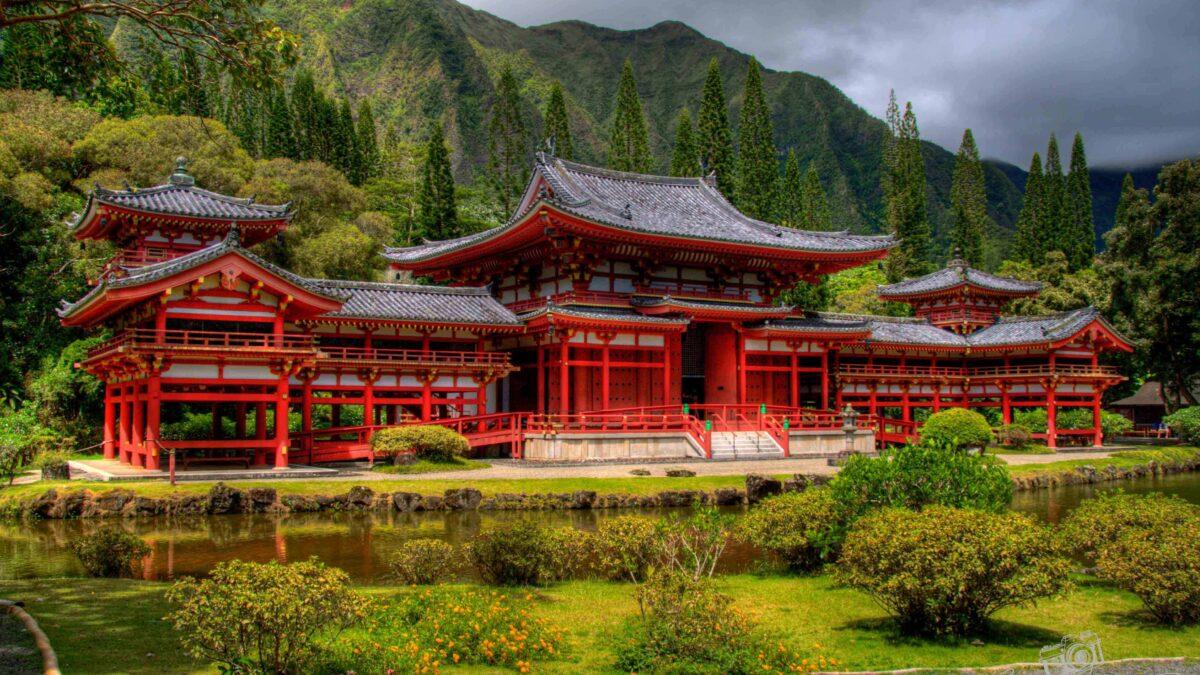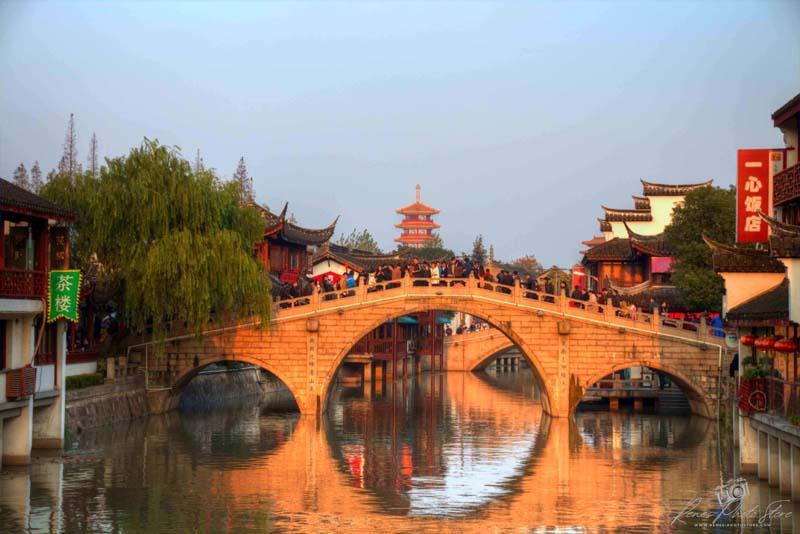Where East Meets Island: The Living Legacy of Byōdō-In Temple, Oahu
The sun stood directly overhead, pouring clear, bright light across the Valley of the Temples. I stood at the edge of the lotus pond, the air warm and still, carrying the soft rustle of bamboo and the occasional splash of a koi breaking the surface. Before me, Byōdō-In Temple rose in quiet elegance—its vermilion pillars, sweeping rooflines, and delicate carvings glowing under the Hawaiian sun. The water before it was a flawless mirror, doubling the temple’s symmetry, the peaks of the Ko‘olau Mountains framing the scene like a living painting.
This was not sunrise. This was daylight in full presence—a moment of clarity, color, and calm. I had come to Oahu seeking more than surf and sand. I wanted to understand how cultures blend, remember, and endure. And in this peaceful valley on the windward side of the island—25 miles from Honolulu, nestled in Kāne‘ohe—I found a place where Japanese heritage and Hawaiian spirit quietly intertwine.
The photo I captured that afternoon—of sunlight dancing on water, of ancient design standing firm in a tropical paradise—was more than a beautiful image. It was a story of migration, memory, and meaning.
A Temple Born from History and Heart
The original Byōdō-in in Uji, Japan, was founded in the 11th century as a private villa for the powerful regent Fujiwara no Yorimichi, later converted into a Buddhist temple dedicated to Amida Buddha—the celestial figure of infinite light and compassion. It was built as a physical embodiment of the Pure Land, a Buddhist paradise where devotees could be reborn through faith and devotion. The temple’s centerpiece, the Phoenix Hall (Hōō-dō), was designed with symmetrical wings and a central sanctum to resemble a phoenix in flight—a symbol of transcendence, renewal, and divine grace.
Designated a UNESCO World Heritage Site and one of Japan’s most treasured cultural landmarks, the original Byōdō-in has survived wars, fires, and time itself. Its exquisite Byōdō-in Amida Buddha statue, crafted in 1053, remains one of the finest examples of Heian-era artistry.
Fast forward to 1968—a century after the first wave of Japanese laborers arrived in Hawaii to work on sugar plantations. These immigrants brought their language, food, faith, and traditions, shaping the islands in profound ways. To honor their legacy and the centennial of Japanese arrival, the Japanese-American community of Hawaii came together to build a symbolic gift to the state: a replica of the Phoenix Hall, not as a place of worship, but as a non-denominational sanctuary of peace, reflection, and cultural pride.
Thus, Byōdō-In Temple in Oahu was born.
Unlike its Japanese counterpart, this temple is not an active monastery. It contains no resident monks, holds no daily rituals. Yet it is deeply spiritual—a place of quiet reverence where visitors light incense, ring the peace bell, and leave offerings of gratitude. Its name, Byōdō-in, means “Temple of Equality”—a reference to the Pure Land belief that all beings, regardless of status, can attain enlightenment. In Hawaii, that message resonates powerfully in a multicultural society built on shared labor and mutual respect.
Architecture in Harmony with Nature
The temple was constructed using traditional Japanese techniques, with wood joinery instead of nails, and painted in the classic vermillion (shu) and white hues that signify sacred space in Japanese architecture. Its phoenix-shaped roof, complete with bronze bird statues at each end, faces the rising sun—a nod to renewal and hope.
But what makes the Oahu version unique is its setting. Nestled in a lush valley once used for taro farming, surrounded by tropical flora and towering mountains, the temple doesn’t feel transplanted—it feels integrated. The lotus pond, home to koi and water lilies, mirrors the original’s design, but here, the lotuses bloom in vibrant Hawaiian colors. Peacocks—introduced from a nearby estate—strut freely, their iridescent tails fanning in the sun like living art.
The mountains behind the temple, the Ko‘olau Range, were formed by a volcanic eruption over two million years ago. To Native Hawaiians, these peaks are sacred, believed to be the bones of the earth mother, Papa. That a Japanese temple now sits in their shadow is not a clash of cultures, but a dialogue—one of respect, coexistence, and shared reverence for nature.
A Living Symbol in Modern Hawaii
Today, Byōdō-In Temple welcomes over 400,000 visitors annually, drawn not only by its beauty but by its message of peace and unity. It’s a popular spot for meditation, quiet contemplation, weddings, and cultural education. School groups visit to learn about Japanese history and immigration; photographers come at all hours to capture its changing reflections.
Yet its popularity brings challenges. Foot traffic, humidity, and salt air slowly wear on the wooden structure. Preservation efforts—led by the Valley of the Temples Memorial Park and supported by cultural organizations—include regular maintenance, climate monitoring, and visitor education to ensure the temple endures for future generations.
Tourism, while vital, must be balanced with reverence. Unlike many historic sites turned into photo backdrops, Byōdō-In still feels sacred. Visitors are asked to remove shoes before entering the viewing platform, to speak softly, to leave offerings with intention. It’s not a museum. It’s a living monument to cultural memory.
Why This Photo Captures the Essence of Place
The image I captured that afternoon—in full daylight, with the temple bathed in sun, its reflection sharp in the pond, mountains rising behind—is more than a scenic shot. It embodies the harmony of opposites: ancient and modern, East and Pacific, human design and wild nature.
The composition is naturally balanced—the symmetry of the temple echoed in the water, the vertical rise of the rooflines mirrored in the mountain peaks. The colors—crimson, gold, emerald, and azure—pop under the midday sun, yet feel serene, not loud. The scale is striking: the temple is modest in size, yet it commands the landscape through grace, not grandeur.
This is the essence of Byōdō-In: not dominance, but harmony. Not worship in the ritual sense, but reverence in the quiet act of being present.
Own This Moment of Peace and Heritage
This image is available as a high-resolution digital download—no physical product included.
Crisp detail, museum-grade resolution, and optimized color grading make it ideal for:
- Home or office decor – Print it for a calming focal point in a living room, bedroom, or meditation space.
- Digital frames or wall art – Use on smart displays or as a canvas print to bring tranquility to any environment.
- Designers, publishers, educators, and marketers – Licensed for editorial and commercial use, perfect for travel magazines, cultural projects, wellness brands, or educational materials.
Whether you’re drawn to its Japanese heritage, its Hawaiian setting, or its universal message of peace, this photo captures a place where history, beauty, and belonging converge.
Purchase it now and bring the spirit of Byōdō-In into your world. CLICK HERE!!!



